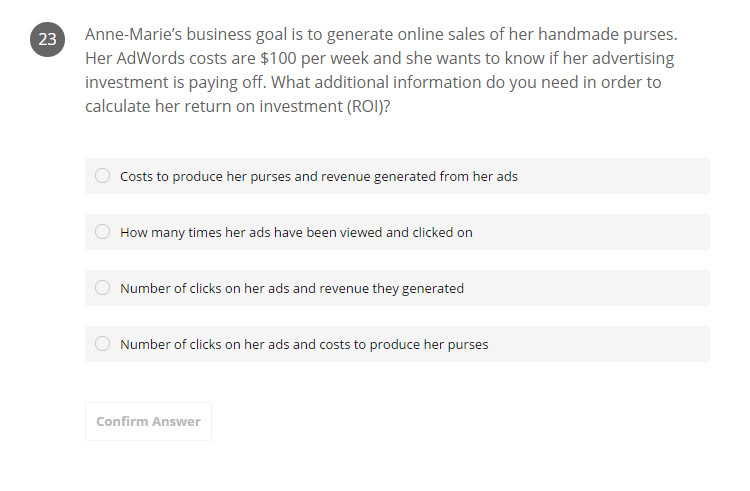Last updated on May 5, 2020

Introduction
This is a short post explaining the correct way to calculate ROI for online marketing. I got the idea earlier today while renewing my Google AdWords certificate and seeing this question in the exam:

Now, here’s the trap – I’m arguing most advertisers would choose the option C, although the correct one is option A. Let me elaborate on this.
The problem?
As everybody knows, ROI is calculated with this formula:
ROI = (returns-cost)/cost*100%
The problem is that the cost side is oftentimes seen too narrowly when reporting the performance of online advertising.
ROI is the ‘return on investment’, but the investment should not only be seen to include advertising cost but the cost of the product as well.
Let me give you an example. Here’s the basic information we have of our campaign performance:
- cost of campaign A: 100€
- sales from campaign A: 500€
So, applying the formula the ROI is (500-100)/100*100% = 400%
However, in reality we should consider the margin since that’s highly relevant for the overall profitability of our online marketing. In other words, the cost includes the products sold. Considering that our margin would be 15% in this example, we would get
- cost of products sold: 500€*(1-0.25) =425€
Reapplying the ROI calculation:
(500-(100+425)) / (100+425) * 100% = -4.7%
So, as we can see, the profitability went from +400% to -4.7%.
The implications
The main implication: always consider the margin in your ROI calculation, otherwise you’re not measuring true profitability.
The more accurate formula, therefore, is:
ROI = (returns-(cost of advertising + cost of products sold)) / (cost of advertising + cost of products sold)
Another implication is that since the ROI depends on margins, products with the same price have different CPA goals. This kind of adjustment is typically ignored in bid-setting, also by more advanced system such as AdWords Conversion Optimizer which assumes a uniform CPA goal.
Limitations
Obviously, while the abuse of the ‘basic ROI’ calculation ignores the product in the cost side, it also ignores customer lifetime value from the return-side of the equation.
Dr. Joni Salminen holds a PhD in marketing from the Turku School of Economics. His research interests relate to startups, platforms, and digital marketing.
Contact email: [email protected]